
In all likelihood, even if you haven’t given this much thought, you already have the makings of a brand. It’s up to you whether or not you want to build on what you already have or start anew, with a fresh branding strategy.
Defining your brand is a process that takes time for the blogger who’s just now considering their brand. It requires you to spend some time thinking about your goals as a blogger, and how you want your readers to see you, read your posts, and interact with your blog.
How do you want your readers to see you?
Do you want them to see you as an expert in your field? Do you want them to contact you for advice? Do you want them to laugh?
In the sections that follow, you’ll learn how all of the different aspects of your blog go into defining your brand to the world. And yes, we want you to think that big. The world is your audience.
You’ll learn about naming your blog or company, choosing a domain name and a design that fits, defining your writing style and sticking to it, using different post lengths and frequency, and developing the supporting pages around your blog to give visitors the best possible experience when they come to your blog.
This first chapter is the most important. Once we’ve defined your brand, we’ll lead you on the path of growing that brand and using it to drive the kind of traffic and income you dream about.

To start with, ask yourself one simple question: “Why are people reading my blog?” The answer to that question will begin to lead you toward an idea of what your brand will be. It will help you to define your goals. It will tell you who you’re writing for. And it will give you a pretty clear picture of what you’re writing about.
How do you know the answer? That can be a bit harder to figure out, especially if you’re just starting out or if you’ve yet to amass a great deal of readers. But take a look at your posts. Take a look at other blogs on similar topics. What makes you different?
Maybe people are reading your blog because they’re interested in the same area as you. But that’s not all. What else about your blog keeps them interested? Is it the way you write? Is it the amount of knowledge you have on a particular topic? Is it humor?
Whatever it is, it’s important that you capture it and use it to help you define your brand and your blog moving forward.
Take a look at what good branding can do: Michela Chiucini (www.webislove.com) has one of those blogs you just want to stay on for hours at a time. No wonder, as one area she specializes in is blog design. Chiucini is a world-renowned web designer based out of Tuscany who has an extensive portfolio that includes Bigodino, Esn Card, and Napa, among others. “A blogger must first find her/his niche and define the audience,” she says. With this in mind, she or he can start to define the brand: the tone of voice, the level of engagement expected, the design, the style, the logo, the content, and everything else that will make up the brand. Every aspect will contribute to define the brand of the blogger.
And yes, it’s that large of a scale that we’re dealing with here. People who are new to branding will be surprised at just how much goes into a successful brand. But think again about the large companies that have worked long and hard to brand themselves.
Think about Apple. What goes into branding Apple? Everything you see and hear from them, from the commercials on television to the billboards on the Street, from the design of their retail stores to the design of their products, from the CEO giving a presentation on stage at a product launch to the genius selling you your new iPhone—they’re all part of their brand. If any of those things did not follow or contribute to the brand, it would stand out. It would change the user experience for anyone who purchases or uses Apple products. And Apple, driven by perhaps one of the greatest branding experts of all time, the late Steve Jobs, just could not afford that.
So that’s what branding is all about: creating an online personality for your blog that’s identifiable to your readers.
Joe Pulizzi, co-author of Managing Content Marketing, believes it’s helpful to visualize your ideal reader when brand strategizing. “Try putting the reader first. Then build an audience persona—a real-world idea of what your ideal reader might look like, and write to that.”
Think of branding the way you think of a person’s style. When we talk about “branding,” we’re really talking about making everything in your blog match. Not that you have to have only one font or color, but that the mood and personality of every part of your blog is identifiable as your brand. Branding is important for bloggers to learn about and understand because, face it, with so many blogs out there, and new ones popping up each hour, you need to make yourself stand out from the pack. Every part of your blog, from the posts written to the logo you create, will come to define your brand.

When most bloggers are just starting out, the idea of branding is simply not on their minds.
Depending on the field that you’re in and the education you’ve pursued, you probably don’t know much about what branding is, let alone why it might be an important part of running a successful blog.
The first focus is always on just getting started. And really, that’s not a bad place to start.
According to Zac Johnson, successful blogger and author of Blogging Tips: Confessions of a Six Figure Blogger, “The best way to get started in the world of blogging is to actually get started. Don’t worry about spending a ton of money on guides or consulting with gurus. You can easily get set up with your own domain name and hosting for only a few dollars a month. It’s much more effective to learn everything as you walk through the process than trying to read everything you can about blogging and never actually getting started.” As with anything, the adage “just do it” applies. It’s important to really put yourself out there and establish your identity as a blogger before making any serious branding decisions. “You need to actually get started and learn through your actions, successes, and failures,” said Johnson. So first, prior to branding your blog, you must start blogging.
Thousands of blogs are started every day for a variety of different reasons. They can begin simply as an outlet to express oneself, a vehicle to further promote a business venture, or as a source of emotional release, allowing one to cope with the difficulties of daily life.
I’ve seen blogs about bringing a child into the world, blogs about building a new home, blogs about helping out in developing countries, and blogs about blogging. Basically, whatever topic you consider blogging about, chances are there’s already a blog on that topic. A quick Google search will prove me right.
So why should I start blogging if there’s already one (or many) blogs in my niche?
How can I ever expect to be successful?
That’s where branding comes in. As I said before, and as I’ll continue to bring up later in this book, your brand will help you stand out from the blogs in your niche and become a go-to source for many readers.
What are the worst branding mistakes you’ve seen?
As someone who works in the business opportunities market, the worst branding mistakes I’ve seen involve taglines which are simply unbelievable.
For example, “Make $1,893 a Day with NO Website” or “How To Make $1000 Daily The Lazy Way” are out-and-out lies.
Yes, people buy into the myths, but soon learn that they wasted their money on bogus schemes.”
—Ros Gardner
Net Profits Today netprofitstoday.com

Think about Starbucks. Were they the first place to offer fresh coffee on the go?
No. But they defined themselves in a way that was very different from the other companies that were already operating in that space. The goal was to take the appeal of a local coffee shop and turn it into a chain that could expand across the country.
So how did they do this? First, they set about creating a café look and feel, something that people who enjoyed coffee houses could identify with. The coffee had to be good. The atmosphere had to be hip. And the menu had to be distinct. Starbucks is a story of branding success. They took this vision and developed a now worldwide chain of coffee houses that look and feel like local places no matter where you are. They have become prime places for coffee lovers and fans all over the world. When you go into a Starbucks you know what to expect, because you’re familiar with the brand, which took a lot of time and energy to build.
Let’s take a look at a few bloggers who got started for different reasons but all found a level of success that they didn’t expect. I’ll keep referring back to these and other successful bloggers and branding experts throughout the book to give you a real-world picture of the advice provided.
Robin Callan, owner of Room Fu— Knockout Interiors and operator of the 2012 Homie-nominated blog Fu For Thought (roomfu.com/blog), explains how her blog started out as a marketing tool. But it never stopped growing.
“It started out purely as a way to market my design business, but it has taken on a life of its own,” Callan says. “Blogging is an opportunity to show more of my design style than you might see in my portfolio, and it gives potential clients insight into my personality as well. Since chemistry is one of the most important elements of a working relationship between a designer and client, this is a unique way for us to have that feeling of connection before an initial consultation.”
Emily Rapp, author of the powerful memoir Poster Child about her experience growing up with a prosthetic leg, started her blog for a completely different reason. Her blog, Little Seal (ourlittleseal.wordpress.com), about her son’s terminal illness is lively, fresh, and free of self-pity. It was also on Time magazine’s list of the 25 Best Blogs of 2012. Rapp’s story reveals her undaunted spirit, a spirit that permeates every sentence she types. “My good friend Weber suggested that I start a blog in the weeks after Ronan was diagnosed,” says Rapp. “Initially I was writing in it every day, and it gave me a great sense of peace and purpose in the midst of a completely chaotic situation. It also helped shape the voice and style of a full-length book project. The book, called The Still Point of the Turning World, is published by Penguin Press.”

Famed freelancer, blogger, Super Affiliate marketer, and instructional author Ros Gardner (netprofitstoday.com)) says you shouldn’t start a blog on a topic just because you think it’ll sell. Instead, follow your passion. “Blog about a topic that truly interests you,” Gardner says. “It’s extremely difficult to discuss a topic one knows nothing about, which makes it impossible to make honest, in-depth product recommendations—and surfers don’t buy from sites where lack of knowledge and experience is obvious.” Of course, this is time consuming, so make sure you have the commitment in addition to the interest. “It takes time and energy to create a content-rich site that’s popular and is trusted by visitors. If you can’t fathom writing about a particular topic in a year from now, you should consider choosing another topic,” Gardner says.
Carefully choosing your content area based on your own knowledge and experience is a crucial step in the development of any high-traffic blog.

Once you’ve decided you want to start a blog, and you’ve chosen a topic you’re truly passionate about, the next step is to define your brand. According to Pamela Wilson (bigbrandsystems.com), award-winning graphic designer and marketing consultant, this is a two-step process that happens internally first, and then externally.
The first part comes from carefully considering what your blog is, and what you want it to do. “First, you have to do some internal work to get clear about who you’re trying to reach, the tone you’d like to strike, and the message you’d like to communicate,” she says. “Getting clear about who you’re trying to reach means understanding who your ideal reader is. You want to have a vivid image of this person in your mind: what is their gender, age, education level? Many people resist this step, saying, ‘I want to appeal to everyone!’”
But we know what happens when you try to please all the people all the time; you lose sight of your own vision and you end up appealing to no one.
“Unfortunately, when you try to appeal to a broad audience, you tend to water down your brand to the point that it makes no impact,” Wilson says. “It works better when you know exactly who your ideal customer is, and you speak in a way that will appeal to that person. Once you know who it is you want to reach, striking the right tone becomes easier,” she says. Wilson advises considering three factors in how your ideal customer communicates.
 How do they speak about their challenges? What words and phrases do they use? How would they describe what it is they see and go through on a daily basis and how can you relate to them?
How do they speak about their challenges? What words and phrases do they use? How would they describe what it is they see and go through on a daily basis and how can you relate to them?
 How much time do they have on their hands? Are they readers, skimmers, or would they prefer to watch video? How in depth do they want you to go on any particular topic and how much of what they’re looking for is fact versus opinion?
How much time do they have on their hands? Are they readers, skimmers, or would they prefer to watch video? How in depth do they want you to go on any particular topic and how much of what they’re looking for is fact versus opinion?
 What else do they consume? What magazines, websites, and entertainment are popular among the group you’re trying to reach?
What else do they consume? What magazines, websites, and entertainment are popular among the group you’re trying to reach?
Understanding your audience is an important factor in determining how you want them to experience your blog and interact with its content. “Instead of thinking of your audience as a collection of people,” say Andrew Boer and Andrew Eisner (“The Andrews”), President and COO respectively of the content marketing agency Movable Media (movablemedia.com), “think of them as a brand. What do they stand for? Could you give them a name?
Would they self-identify with it?” Asking these fundamental questions will provide you with a better perspective on the relationship between your brand and your audience and how the two influence each other.
Think about Walmart. What does Walmart stand for? We can all remember their “Everyday Low Prices” slogan. The brand is all about giving people a place to shop for anything and everything that they need at the lowest prices around. Walmart defines their audience, albeit a rather large one, as shoppers who are in need of or looking for a bargain. They know what they want and they want it to be inexpensive. They care about convenience, and they’d like to get everything they need in one trip from one supplier.
Using this definition of their audience, they know who they’re not trying to appeal to. They know they’re not appealing to the fashion aficionados who shop at brand name designer stores and go into storefront after storefront, hunting down the item that fits their style the best, even if it means trying on many different items. They know they’re not going after the early-adopting tech crowd who don’t care about price as long as they can get their hands on the latest and trendiest gadget before all of their friends.
Knowing who you’re trying to reach is important. But even more vitally, it tells you who you’re not trying to reach. And the beginnings of a brand start to form around both of those ideas. It will help you decide what and how to write about a topic, and what you can leave out altogether.
Even before you’ve built an audience, you have to make some decisions about how you’ll present yourself. “After you gather some readers around your work, you can base your information on interactions with them. Once you understand your audience and have decided on a tone, you should develop an overall message. This is a phrase, or a sentence or two, that remind you of the purpose of your blog,” says Pamela Wilson.
This overall message, which is known in the marketing world as a mission statement or brand promise, is the foundation upon which every successful blog is built. Wilson can attest to its importance to the success of her own blog. “In the case of my blog, Big Brand System, I help small business owners learn about marketing and design so they can promote their businesses themselves,” she says. “The overriding message behind all my posts is ‘you can do this.’ I don’t write about problems without offering a solution. I always write with the goal of empowering the reader to do more for their business. Keeping this overall message in mind has helped my blog stay focused and consistent through the years.”
It’s necessary to constantly revisit your mission statement to ensure your blog hasn’t lost focus and you’re staying true to the goals you set out for it. However, just like a blog, a mission statement shouldn’t be set in stone and should be altered if you find your brand changing over time.
So that’s the internal work you have to do first. Once you’ve got that all settled, you can start looking at how to express your brand externally, “through your choice of blog name and tagline, domain name, and website style,” Wilson says. “Remember: the internal sets the stage for the external. It’s not sexy to do the internal work, but the external expression of your brand won’t be successful unless you’ve got the internal components right.” Also, making sure your internal and external components mesh is vital to growing your brand and increasing your blog viewership. If they don’t, your approach will be inconsistent and your reader will have trouble trusting you.
So how do we take the internal work and begin to create the external?
Let’s find out.


The first of these external steps is to choose a name. But unlike naming your baby, naming your blog also involves choosing a domain name. You may come up with the most clever name for your blog about decorating, say, “Apartment Therapy” or “Design Sponge,” and get the whole site designed around that name, only to find out those domains are already taken. (As they are, in fact, by a couple of great blogs on interior design and décor).
Your starting point should be to brainstorm a list of potential domain names that pertain to your topic, maybe with a couple of creative friends. You can then upload your list of names using the bulk upload tool on a number of domain purchasing and management services such as GoDaddy, Register.com, or Network Solutions to see which are available.
If you can’t think of any good names, Dot-onator.com is a useful website which generates domain name ideas and word combinations. Aim for a name that will tell the reader something about the content, but which will also tell the reader something about the style. For example, Paris Imperfect, a blog by the displaced New Yorker Sion Dayson, is about living in Paris and about being a writer. The name captures all of that and lets the reader know there’s also a certain amount of self-deprecating humor in the blogger’s point of view.
There are a couple of different schools of thought when it comes to selecting a domain name and naming your blog. In the past, many people thought it was okay to name your blog something completely different from your domain name. For example, your domain name might be your name, joeschmo.com, even if the name of your blog was “All About Eggs.” The two don’t relate, but as long as people understood where to go to find AH About Eggs, who cares?
In fact, using your name as a domain is a very popular practice, even if the name of your blog is different.
But today’s websites and blogs become defined by their URLs. The name of the blog and the domain name become the same thing, and when there’s a disconnect, it can be confusing for the reader. So my recommendation is always to choose a domain name that matches the name of your blog. And you’ll find that most of the blogs we’ve profiled in this book follow that practice.
So consider naming your blog, and finding an available domain name, both one and the same. Domain names can be hard to come by, and the one you want may not always be available to you. So be prepared to be creative, or to do a little extra work to get the name you want.
Michela Chiucini, whose Web Is Love blog has a terrifically compelling design, says that you need to really think hard about your domain before buying it. “The domain is a tricky one; it requires a bit of luck and/or a bit of creativity. In general it should be easy to remember and related to the content. In that way the audience will remember it.” Once you’ve come up with a few names, you must check and see if the domains have been taken by others.
To do this, you have to first go to a reputable domain marketplace that aggregates a Wide variety of auctions, such as domaintools.com orsedo.com. The next step is to type each of the domain names into your search bar and see what comes up. Break the pages you find into four distinct categories based on their characteristics, including pages that are non-existent, pages that are under construction, pages that are links to other sites (often for lead generation), and real businesses.
After identifying the status of each page, you can use the contact information provided to try and get in touch with the domain owners to see if the name is for sale. Some sites will embed a contact link for those who are interested in purchasing the domain name (this typically makes negotiations easier, but more on this later). If no contact information is provided or the page is dead (this doesn’t necessarily mean no one owns it, just that it hasn’t been maintained), you can search the Internet Archive (archive.org/web/web.php) to find old pages and contact details or do a WHOIS search on any reputable query database for domain registration information.
Tracking down the owners and communicating with them can at times be a slow and arduous process. However, your patience and persistence may be rewarded if you end up purchasing a strong domain name for little money. Sometimes it’s next to impossible to locate the owner, in which case you’re probably best served to just move on to other options.
If it’s your first time purchasing a domain name, contact the owners directly. If instead you’ve purchased a string of domains and your contact information and business history can be found easily through a Web search, you may want to think about masking your identity by using one of a number of techniques. This is because the owners are more likely to quote you a higher price if you have a history of buying up domain names. One quick and easy way to mask is to create an anonymous Yahoo! or Gmail account without any of your contact information listed. If you don’t, the domain owners are more likely to think you’re a scammer and may be hesitant to sell to you.
If you’re willing to pay for this service, you can use a website that offers masking capabilities, such as networksolutions.com, or you can hire a small law or PR firm with a website and use a Web address that they create. This ensures that the domain owners will think you’re a real person but won’t necessarily try to highball you in pricing negotiations. When making first contact with the owners, it’s important to remember not to make an initial offer before determining if the domain is for sale or not. Once you enter into negotiations, have a valuation in mind, since you’re unlikely to have any point of comparison to determine what you should pay.
In the end, naming your blog shouldn’t be all that much of a hassle. It’s the first step in branding, as the name that you choose will be synonymous with your brand in the long run (we hope). But it’s not the be-all and end-all of defining your brand. So don’t get all your hopes set on one name only to find out you have to settle for something else down the road.
Be flexible. And be creative. That’s what makes a strong name easy to find.

Launching your blog will require a certain amount of design. Maybe you already have a design on your blog, or maybe you’ve started blogging without worrying too much about the way that your site looks. What you’ll learn is that everything about your blog contributes to the way people view it. The length of your posts, the font that you use, the colors, the pages, and the elements on the top and side of each page will all impact the way your blog looks.
Design has a lot to do with your brand. It should create a visual impact on the readers who frequent your site. Your most avid readers will feel at home there. Designs can be very simple or very complex, but the key is consistency.
In the sections that follow, we’ll talk about the design of several key elements on your blog. The design aspect of your site is one that should be considered carefully. Most blogging platforms will allow non-programmers or non-designers to use simple tools to affect the way a blog looks and feels. But many of the most successful bloggers have realized the need for a more advanced level of expertise in design. If you’re not familiar with Web design or have little experience with what makes a design successful, I recommend that you hire or consult a professional for many of the elements mentioned in this section. A professional will bring a certain amount of experience and familiarity to the table that will help the overall appeal of your blog.
LOGO
The first part of your blog’s design on which you should focus is the logo. The logo should be something that will capture the essence of your brand and what you’re trying to communicate to your readers, just the way your name will.
Think, for example, of how the seemingly timeless Coca-Cola logo has become synonymous with the very product the company is advertising and the way it’s viewed by the consumer. You don’t need to listen to a sales pitch for the product. You don’t need to see someone drinking a can of Coke. You don’t even need to see the name of the company spelled out separately. When you see the logo, you think Coca-Cola. You think of all the times you’ve seen or interacted with the product. It’s a brand, above all else.
Your logo should be simple. Most blogs use the name of the blog in the logo. It should be something that’s readily recognizable and easy to duplicate. Your logo will become the key image that you can use and share anywhere on the Web to direct people to your blog. Eventually, when people see your logo they should know who you are and that the content associated with your logo is yours and yours alone.
Your logo is often the first thing that appears at the top of your blog, in an element we refer to as the website header.
According to Pamela Wilson, “This is the first thing your visitors see when they land on your site, and it sets the tone for everything that follows. It’s important, obviously, that your site header state the name of your blog. You want to reassure your visitors that they’re in the right place.”
“Beyond that,” she says, “I’m a proponent of keeping things simple. State your blog name with a unique font (find a free one at fontsquirrel.com) and you’ll be done. Apply a color or two as a bonus, and it will look even better. And while it’s important to carefully choose a header, remember that it may change over time,” Wilson says.
Keeping your mission statement in mind when developing your blog’s visual identity is crucial in order to ensure that the two form a united front for your brand. This is, of course, subject to change as your blog grows and your goals evolve. “Later, as you develop a relationship with your readers, you can spring for a more elaborate header design. It’s usually better to wait until you truly understand your audience before you invest too much in a website header,” Wilson adds.
There are some common mistakes to avoid when designing your logo. These mistakes are made every day by large companies, so don’t feel bad if you’ve already made some yourself. Experimenting with your logo and modifying it over time is common. But when you get something you’re happy with and appeals to your readers, keep it consistent. This will make you more recognizable than someone who is constantly changing their look.
 The first mistake is to copy another logo. It might be easy to choose a well-known company and assume they know something about logo design that you don’t. Copying a certain look might make you think you’ve tapped into some expertise and allow you to achieve the same level of success. But one of the keys of a strong logo design is uniqueness. Express yourself and who you are instead of trying to duplicate someone else’s success.
The first mistake is to copy another logo. It might be easy to choose a well-known company and assume they know something about logo design that you don’t. Copying a certain look might make you think you’ve tapped into some expertise and allow you to achieve the same level of success. But one of the keys of a strong logo design is uniqueness. Express yourself and who you are instead of trying to duplicate someone else’s success.
 Another common mistake is the use of stock art. I see this all the time. Once again, elements of a logo should be unique. If you use a piece of art that everyone’s seen on other sites, it makes your logo look cheap and amateurish.
Another common mistake is the use of stock art. I see this all the time. Once again, elements of a logo should be unique. If you use a piece of art that everyone’s seen on other sites, it makes your logo look cheap and amateurish.

Two classic examples of similar logos (whether intentional or not).
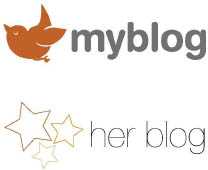
Some of the most used stock logos (birds, globes, arrows, stars, and leaves) can make your logo look generic and ordinary.

After a 2010 election, the Chilean government unveiled a logo for the transitional government which is a perfect example of an overly complex logo design.
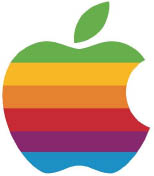
Apple computers used a rainbow of colors in their logo which was used from 1976 to 1998. It was redesigned to a monochromatic version that is still used today.
 A third common mistake to avoid is creating a logo that is too complex. Complexity is something to avoid in all aspects of your blog’s design. Complexity makes information more difficult to process, and it makes recreating a design that much more difficult. Unique does not mean complex. You can achieve uniqueness in a simple design, and that is what you should aim for at all times.
A third common mistake to avoid is creating a logo that is too complex. Complexity is something to avoid in all aspects of your blog’s design. Complexity makes information more difficult to process, and it makes recreating a design that much more difficult. Unique does not mean complex. You can achieve uniqueness in a simple design, and that is what you should aim for at all times.
 The final mistake that you want to avoid is the use of too many colors or too many fonts. Your logo’s color will come to define the colors that readers will associate with your brand. One or two colors is plenty, and reduces confusion. The same goes for the fonts that you choose. Use a font that effectively communicates the style of your blog, and don’t try to complicate things with a combination of multiple fonts.
The final mistake that you want to avoid is the use of too many colors or too many fonts. Your logo’s color will come to define the colors that readers will associate with your brand. One or two colors is plenty, and reduces confusion. The same goes for the fonts that you choose. Use a font that effectively communicates the style of your blog, and don’t try to complicate things with a combination of multiple fonts.
A good idea for coming up with a final logo design (or any design for that matter) is to come up with what you think works the best and try it out.

Gather a group, preferably made up of the same type of people as your audience (as defined by you in the previous section). Present them with several different variations of the logo that you’ve come up with. To keep things interesting, throw in some logos that are different than what you’ve chosen. Ask them for feedback. What do they like? What don’t they like? What kinds of emotions do they have when they see your logo?
What do they expect to see, or what do they associate the logo with?
The feedback that you get from this focus group style interaction will tell you how people will see your logo.
A key to creating something that appeals to your audience is to get real, honest feedback from the audience you seek.
You’re not designing for yourself, you’re designing for your readers.
Once you settle on a logo, designing the pages of your blog around that logo becomes key.

PAGE DESIGN
The best blogs have a professional design. But it’s not always necessary. Much of how your blog looks will depend on the style and topic that you’re writing about and the type of people it will attract. Some of the most successful blogs in the world look simple.
You wouldn’t know by looking at them how much time and energy has gone into creating something so bland.
Once you have the name, you’ve bought the domain, and you’ve designed a logo, it’s time to design the entire blog. Look at any successful blog and you’ll notice that it has a look and feel that is consistent throughout the site. Everything from the colors, to the fonts, to the size of the text, to the use of graphics affects the way that your blog looks.
Michela Chiucini advises that a blogger should hire a designer unless he or she is design-savvy. “If the blog will become popular, the logo will be popular as well. If the blogger is not a designer, it’s better to hire a professional that can do it. Websites like dribbble.com are full of professional logo designers,” she says.
Robin Callan opted for this approach. “My blog is part of my design business website, so its look and feel is consistent with the rest of my site,” Callan says. “I can’t take credit for it though; I was smart enough to hire Austin web designer Karen Barry to do the heavy lifting where the design is concerned! But the overall idea was to use color and imagery that projected ‘modem’ and ‘fun,’ with plenty of ‘Keep Austin Weird’-ness thrown into the mix. That’s the prevailing state of mind here in our capital city and I’m proud to be part of that,” she says.
How should you choose the predominant elements of your blog’s background and graphics?
Let’s delve into design a little bit deeper.

FIVE THôT (getthefive.com)
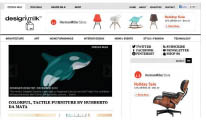
Design Milk (design-milk.com)
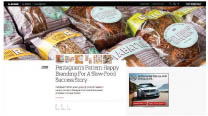
Fast Co. Design (fastcodesign.com)
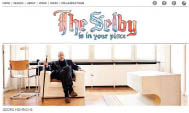
The Selby (theselby.com)
Examples of well-designed page layouts for blogs and websites.

COLORS
Pamela Wilson explains it very simply: “When it comes to colors, my advice is to choose two colors to emphasize on your site. Don’t count black type or your white background. Simply add these two main colors to your page, and emphasize them over and over throughout your site elements like subheads, graphics, and link colors.”
So what colors should you choose?
Color choice is important in any blog design. It’s a form of non-verbal communication that says a lot about who you are and what you’re trying to convey. Think about the colors of some of the world’s most famous brands. Coca-Cola’s red, Apple’s white, Facebook’s blue, Best Buy’s yellow, Yahoo!’s purple. They all have a dominant color that’s easily recognizable and identifiable. That’s what you want, something that says something about you.
Colors bring with them certain emotions. For example, red is often associated with passion and excitement. Blue is often associated with trust and stability, peace and tranquility. Yellow is often associated with liveliness and energy. Orange is associated with ingenuity and creativity. Purple is associated with nobility and wealth. Green is associated with harmony and life.
The color you choose to be your dominant color should have something to do with the way you want your readers to feel when they first land on your website. A blog with a green dominant color will be viewed differently than if the same blog had used red.
Once you choose a primary color, refer to a color wheel to help you develop secondary colors around the dominant one. It’s not just designers who think there are colors that naturally go with one another. We all think this, though our feelings may be a little more subconscious than a designer’s.
The color wheel will guide you to colors that go together. Opposing colors on the color wheel are referred to as complementary colors. Adjacent colors on the color wheel are referred to as analogous colors. These two types of color combinations are seen in the natural world, and are easily recognized by most people who view them on the Web or in any other type of design. Don’t go against the grain here or you’re more likely to create a combination of colors that’s difficult to look at for any extended period of time. That’s not a winning strategy for a blogger who’s trying to draw in first-time visitors and create return readers.

The color wheel.
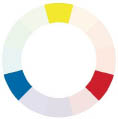
Primary colors.
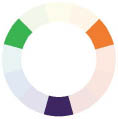
Secondary colors.
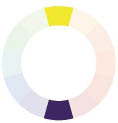
Complementary color example.
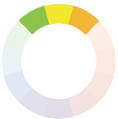
Analogous color example.

FONTS
Beyond that, what kind of font do you want? Comic Sans will give a very different feeling than Baskerville. Try out a few different fonts before settling on the one that best expresses your brand. “I recommend choosing no more than two font families to display on your site. Find two families that have a variety of weights, so you can use regular, italic, and bold versions of your fonts for maximum versatility,” says Pamela Wilson.
Even if we don’t think about fonts when we’re looking at a website, the font choice is still impacting the way we view content. We’ve all tried to read something only to be frustrated by the way it looks. Compare the choice of fonts on many popular blogs and you’ll most likely find that some are easier to read than others.
Check out a website like MyFonts.com to find out what kinds of fonts you like or don’t like. Here you can search for fonts that are most popular, fonts that elicit specific emotions and feelings in the reader, fonts that relate to one another, and fonts that people are using most often.
Once again, the key to choosing a font is simplicity and consistency. Pick something that is simple enough that it has broad appeal. And use it exclusively. If your font changes from one post to another, it will most likely confuse readers. The last thing you want to do when building a successful brand is to confuse people by deviating from what they’ve come to expect.


LAYOUT
The layout of your blog must also be considered, as it’s often just as important in communicating with your viewers as the content you generate. What kind of layout will fit your brand? Would a newspaper format work better or should you use a single column? Will separate tabs along the upper third of the main page represent your blog’s different sections? What kinds of graphics will you use, how will they be organized, and where will they be displayed? When considering the design, the most important factor to keep in mind is that you have a ton of choices. Don’t just go with the obvious, but play with your layout, and experiment until you get a design that really expresses your brand.
Again, listen to the advice of design expert Michela Chiucini: “When it comes to blog design, the aspects related to easy reading and interaction are fundamental. You want people to stay on your website, so be careful with cluttered interfaces and too much content at a glance. A touch of originality plays an important role as well; it allows the blog to stand out and to be remembered and recognized. In a nutshell, I’d say go with a layout for its simplicity and originality.” Too frequently, beginning bloggers think they have to attract traffic to their site with overly elaborate designs and a glut of content. However, this can often drive people away from a site. Many times the best approach is a clean, deliberate design with an easy-to-use interface, and a clear, concise message.
Chiucini emphasizes the importance of knowing your audience and having your design reflect what the Viewer is looking to get out of your blog. “With my own blog design, I went through some revisions and simplifications. I knew my audience would be Web design peeps, so the goal was a simple and flexible design that could be customized with the image of the last post, just enough to not become boring,” she says. I see many blogs put together from one day to another.
For new bloggers, my suggestion is to try to reflect the brand through design and to look for a simple, but meaningful design.
Responsiveness is important as well, as many people today read blogs from their Smartphones.
And while we’re on the subject, certain aspects of your blog’s design will have to be viewable on both desktop computers and mobile devices. We’ll talk a little bit more in depth about mobile devices near the end of the book, but for now we should point out that you have to keep mobile viewing in mind when designing all aspects of your blog. Always remember to double check the way your blog looks on a tablet and Smartphone. If you don’t have one of each, borrow them from a friend.
One of the worst mistakes you can make in today’s digital age, an age in which a higher percentage of people are consuming content online with phones and tablets as opposed to traditional desktop computers, is to fail to consider the way your blog looks on one of these popular devices.


Personality and writing style are two intertwined elements that people don’t spend too much time thinking about. The best writers in the world have perfected a style that is completely theirs. Their readers can tell that this is the author they know and love just by the way something is written. And that’s the goal with your blog: find a writing style that’s completely yours.
The best writing for your blog is your own style. That may sound simple, or it may sound impossible. The trick is to sound exactly like yourself—your own most natural, genuine self. And that can take some time to get the hang of.
Ros Gardner, whose popular blog RosalindGardner.com is a great model of how to be authentic in your writing style, says it wasn’t always so easy for her. “When I started publishing online, I had visions of people being hugely critical of my work, so I strove to make every word perfect. As a result, I sounded stilted and contrived. However, the criticism I feared never carne up. It would seem that by virtue of the fact that you’re willing to put yourself out there, especially when your motive is to help and share with others, brings out the best in people. With my readers’ encouragement, I overcame the oppression of perfectionism and started to write as I thought and spoke. A couple of years after I started publishing online, a woman I met at a conference said, ‘You speak exactly as you write; I would have known you anywhere.’ It’s one of the greatest compliments I’ve ever known. So, my advice is just to be yourself and have fun.”
And the fear of perfection comes up time and time again when I talked to bloggers for this book. It takes a great deal of faith to put your thoughts and opinions, sometimes your entire life, out there for all the world to see. As human beings, we spend so much time trying to protect ourselves, often going to great lengths to try to retain some bit of privacy from the world.
But bloggers are different. Blogging is a step into the public world, even if it’s done from behind the keyboard.
And with that step, you have to be prepared to get negative feedback or criticism. It comes with the territory, and if you spend too much time trying to avoid it, you’ll never really let your true self show, and you won’t be able to reach your fullest potential.
When you write as yourself, as you would speak or write in any situation, you’ll find that it comes naturally. It will make the entire blogging process simpler and smoother. You’ll enjoy yourself and be better able to explain how you really feel.
Too often bloggers try to sound overly professional. They write in a way they wouldn’t normally write, just to sound like an expert. AH that does is make your writing come across as phony and not genuine. You’ll not build any trust with your readers, who can go get the same bland facts from someone who might be a more credible expert.
In addition, trying to sound professional will make writing harder and blogging will feel like more of a job than an activity you enjoy. Running a successful blog already takes dedication, and if you don’t enjoy the work, you’ll find it very difficult to stay the course.
Liz Strauss agrees about the importance of retaining your own voice. Strauss is the CEO and founder of SOBCon, author of SuccessfulBlog.com, and according to Connie Deiken of the Huffington Post, “one of the most thoughtful, prolific bloggers on the planet.” Strauss says, “You are the only you. Use your voice. Your writing voice is the sound of your brand. You are your most powerful tool for connecting with readers. The sound of your voice places your words in our minds and hearts. It’s the business of authenticity. We hear your voice, and we trust what you’re saying.”
So too does Robin Callan, who has adapted the approach to her entire interior design business. “The voice and tone of my blog sets it apart from other designers’ blogs. People expect a practicing interior designer to be a little bit serious, maybe even a little snobby. Let’s face it—interior design has been stuck-up for generations, so I use my blog as a tool to make design more approachable. Part of that effort is allowing a bit of snark and sarcasm to slip in every once in a while. At the end of the day, I absolutely want to gush over beautiful design, but if I see something on a TV decorating show that is butt-ugly, I’m going to call that crap out. Either way, I tell it like it is, and people who read my blog tell me all the time how much they appreciate that.” Michela Chiucini also chimes in, adding: “Find your own voice, your own niche, your own style, and write original content. The Web needs that.”
I love the way Robin and Michela use their blogs to make design more approachable. The blog becomes an outlet to relate to people.
I see this all the time in the blogosphere, and if you follow a number of blogs, you’ll probably see it as well. The blogosphere is filled with strong opinions, quirky characters, big personalities, and at times even bigger jerks. It’s a space that welcomes personality. It’s a new form of journalism that’s looking for the way you fit into the story. By putting more of yourself out there for people to see, you can build a rapport with your readers, who’ll come to accept you and love you for saying what you have to say. That’s what will keep them coming back time and time again.
While being interested in a topic is important, equally important is having some expertise in the subject. This doesn’t mean you have to hold a PhD in agriculture in order to write a successful blog about your farm, but it does mean you should probably have a farm and/or know something about how to grow a good pumpkin.
“When you build a site around a topic about which you’re knowledgeable and have credibility, or about which you’re willing to learn, the result is improved conversion rates, increased sales, and ultimately, success,” Ros Gardner says, adding this for incentive: “Every multi-millionaire I know (and I know many) started their business in a niche about which they were interested, knowledgeable, and even passionate.”
“Don’t be afraid to share your true perspective,” says Robin Callan. Readers relate to authenticity, and they’re more loyal to blogs that aren’t generic.
Bottom line, take the advice your mother has been giving you your whole life, and be yourself.

Beginning bloggers often want to know two things: how long should each post be, and how often should I post? The answer to both depends on the blog, and especially on the readers of the blog.
“Post length should be in response to your readers’ lifestyles. If you’re writing for an audience that has more time to read, you can write longer posts. If your audience is strapped for time, shorter posts are better. It’s important to experiment: try a little of each style at first, and see what the response is. Throw in an occasional audio interview or video post, and see what kind of reaction you get. Your readers will tell you what they want by their comments, sharing activity on social media, and their emails to you,” says Pamela Wilson.
In terms of frequency, before you even start a blog, you should ask yourself if you’re really ready to commit. Nothing says “dead in the water” like a blog whose most recent post is dated a month ago. You should be able to post a minimum of a couple of times each month, according to Wilson. For many blogs, you’ll have to post more frequently.
“If you can’t commit to that, you shouldn’t start blogging,” says Wilson, who posts once every week, on Wednesdays, and starts thinking about the next week’s post on Thursday. By following her lead, you’ll stay constantly engaged with your blog, even when you’re temporarily away from it. “People’s attention spans are short, and less than two posts a month just won’t make enough impact to build your audience,” she says. “From a production standpoint, it’s helpful to choose a specific day of the week to post, and work backward from that.”
When thinking about frequency, consider the production schedule. “I aim for a three-day production schedule,” Wilson says. “I write the headline and mind map the content on the first day, fill in the details on the second day, and look for an image and proofread it one last time on the third day.” Regardless of how frequently you decide to post (perhaps you follow Wilson’s lead and chose to blog every Wednesday), it’s important to stick to a schedule so your viewers know when they can expect new content.
Breaking your schedule too often can lead to your audience losing trust in you and going elsewhere.
You’ll find that all bloggers differ on the frequency with which they post, and the strategy they use to put their posts together. Some blogs post new content every day, the largest ones posting several times each day (usually this involves a team of writers). Some blogs post a couple of times per week. And still others, like Pamela, post once a week or less. The key, I’ll stress once again, is consistency. Once you’ve established a regular pattern, your readers will come to know and expect that pattern. Any deviation from the schedule might result in confusion.
It’s helpful for all beginning bloggers to establish an editorial calendar, and fill it in with the dates, times, and tasks you plan to do going forward. Keep in mind that the calendar should not only include your blog-post production schedule, but also when you plan to read and respond to user comments, market your blog on Twitter, Facebook, and other social networks, and scrutinize your analytics and make the necessary adjustments to your site. It’s equally important to allocate enough time for each item, so you won’t end up feeling overwhelmed, and the quality of the content you produce or the R&D you put into posts won’t suffer. Once you’ve gotten into a routine you’re comfortable with, it’ll soon become second nature to you, making it easier to remain productive and avoid writer’s block. Your editorial calendar should keep you playing the roles of writer, marketer, and blog mechanic, at least until you hire someone to perform those services for you.
When you’re just starting out, it’s important to find a schedule that works for you, and time blocks that you think you’ll be able to stick to. Don’t overcommit yourself at the very beginning. It may be easy to write a lot when you’re just starting out, because you haven’t had a chance to say everything you know about your blog topic yet. But think about what it will feel like a year from now. How hard will you have to try to scrape together a new post? How often do you want to be creating new content, again and again?
And think about the types of posts you’re going to write. Do they require a lot of research? Will you have to find and quote sources? Will you have to find other people to interview? Or will each post be quick and easy, something that just flows out of your own mind?
The answers to these questions will tell you how much time and energy will go into your writing before each post can go live, and it may steer you in one direction or another when it comes to post frequency.
Take a look at some of the other blogs in your niche. Do a quick Google search and start to read through a few of them. How often do they post? What types of posts are they writing? Use this as a guide (though you don’t ever want to copy them exactly).
One particular technique that I advise, and that many a successful blogger employs, is to always have five or more well-written, timeless, publish-able posts saved in your drafts, so if anything comes up last minute and you don’t have time to write a new post, you can just set one of your prewritten ones to publish. Keep holidays, seasons, birthdays, and other events in mind, as they can be hectic times for you and your family. You may think you’ll have the time to get everything done, and maybe you will, but life, as we all know, has a tendency to throw curveballs at us.
When creating posts to save as drafts, it obviously doesn’t make sense to write about a current event that will be old news by the time the post goes live.
Instead, stick to topics that have real staying power and will retain a level of interest in the weeks and months to come, keeping the current issues and topics for your next few published posts. So if you feel like writing up a storm one day, by all means do so, but rather than clicking publish on four posts in a row in a given day, consider saving one or two for a later date when you’re swamped or you have an emergency to attend to.

In addition to your main blog page, where you’ll do the majority of your writing, your blog will need some additional supporting pages in order to be successful. If you look at other popular blogs, you’ll notice these more and more.
Let’s go through a couple of the most important pages and how to use them to support your brand.
ABOUT PAGE
The About page is the first place people will look if they begin to follow your blog regularly. It’s a page that will tell visitors who you are.
As readers of a blog, we want to feel connected to the people behind the content that we most like to consume. It’s a natural thing we all experience. We don’t want to take our advice from, get our facts from, or trust someone who is anonymous. We prefer to feel like we know the person behind the brand. And in that way, the person behind the brand becomes an essential piece of the brand.
All for Your Readers
The most successful Contact and About pages are actually about the reader, not the author.
You have an opportunity on your Contact page to demonstrate that you empathize with your reader’s challenges and want to help them through the language you use when inviting them to get in touch.
And your About page can be mostly about them, their issues, and what kinds of solutions to those issues they’ll find on your blog.
After you’ve established that you understand them and have help for them, then you can talk about why you’re qualified to help.
You can also let visitors know how they can stay in contact with you on your About page: include a contact form, and consider adding social media icons so they can connect with you on whatever platforms you’re active on.
—Pamela Wilson
Big Brand System bigbrandsystem.com

Now, not everyone makes it easy to find out who they are. Many bloggers prefer to remain anonymous, or keep their blogging personalities separate from their personal lives (or even a separate professional life). And you may have a desire to keep these things separate as well.
There’s no binding law here, but you picked up this book for advice, so I’ll refrain from straddling the fence on this one. In my opinion, you should be as open as you can be about who you are and why you’re worth listening to. The most successful bloggers are very open about their lives, their credentials, and their opinions.
The About page is a great place to showcase yourself in the best possible light. Include a headshot so people can put a face to your name. Write up a short bio that addresses who you are and why you write what you do.
This will establish trust and credibility with the reader.
Credibility is a major factor in developing a successful blog and one we’ll address in greater detail later in this book.

CONTACT PAGE
The Contact page is another essential piece of your blog if you wish to grow it into one of the more successful blogs out there. One of the keys to successful blogging is giving your readers a way to interact with the blog. We’ll discuss more about the difference between active and passive readers later, but for now let’s focus on why you want to include a Contact page.
The Contact page gives your readers a way to get in touch with you, outside of the traditional comments section that follows each post. This gives them a way to reach out to the blogger directly. It creates a link from them to you, one that helps to establish your credibility by making you “real.”
A Contact page should include an email address that people can use to get in touch with you or a contact form that automatically generates an email to you.
Many people are careful not to make their email address public at the risk of getting overwhelmed with spam. But a contact form allows you to stay in touch without making your email address public.
In the beginning, you won’t have to worry about being overwhelmed with emails. It will take you some time to build up a large reader base, and it will take your readers some time to write to you. But when they do, be sure to do your best to respond. Even if the message is off topic or seemingly undeserving of a response, your reply will help to establish a bond with that reader. The more personal bonds you forge, the more likely you are to develop relationships with people who frequent your blog. And the more likely they’ll continue to come back, and even recommend your blog to others via word of mouth or social media.
Often a Contact page will grow over time. Some of the most successful blogs include different ways of getting in touch, depending on who’s making the contact. For example, you may have one email address that you use for potential advertisers, one that you use for general inquiries from readers, and one for people who’d like to write a guest post for your blog.
Giving details on how people can get in touch with you, and what they should expect in return, is a good way to avoid email overload once your blog reaches a larger audience.
RESOURCES PAGE
The Resources page (or Links) is a page on your blog where you can direct your readers to additional content in the field outside of your blog posts. This page of links may include papers or articles written by you or other established experts in your niche. It may include a reading list, with links to books on the same topic on Amazon.com. It may include the very sources that you use when writing your posts.
Often, bloggers will include a list of other blogs and bloggers in the same niche that they wish to recommend to their users.
This is often referred to as a blogroll. A blogroll is a list of trusted bloggers in the area that you may have a working relationship with. A blogroll can serve a couple of purposes. In addition to providing resources for your readers, it gives you a way to connect with other bloggers in the space (something that we discuss in more detail in the next section of this book). It gives you something to offer other bloggers, as a link to their blog will be something that most will be very eager to receive— and oftentimes they’ll link back to your blog, too.

ADVERTISER PAGE
lf you wish to accept advertising on your blog as a way of making money, then an Advertiser page is key. This page promotes the fact that you accept advertising, instead of making potential advertisers guess. Be as direct as you want to be on this page.
Most potential advertisers are looking for a couple of key pieces of information, which you can either choose to provide on this page or hold back until they first contact you.
The first piece of information they’re looking for is the type of readers you attract. Often they can tell this just from your content, but if you want to give them some added incentive, then include some simple demographic information. For example, “women in their 30s and 40s that spend X number of dollars each year on travel.” This is a cue to advertisers that the readers of your blog are likely to respond to ads from airlines or other vacation booking services.
The second piece of information that advertisers are looking for is the amount of readers you attract. This information can usually be garnered without your providing it from a free service like Compete.com, but it doesn’t hurt to showcase your numbers here. Boast about your thousands of monthly visitors, your enormous Facebook or Twitter following, or your dedicated subscribers.

Finally, potential advisers want to know what kinds of ads you accept and how much they cost. Here you can show them the sizes and placement of the ads in relation to your content. Usually a banner at the top or along the side of each post will suffice.
Pricing is something that most bloggers won’t display publicly, giving them the ability to negotiate fresh with each new advertiser. When you’re just starting out, keep your prices low. Give your advertisers an incentive to try you out. This will lead to more money down the road as you can prove the success that comes with advertising on your blog.
I want to quickly diverge here to talk a little bit more about advertising and your brand. Most beginning bloggers fit into one of two camps. Either they’re eager to get ads up on their blogs so they can start earning money, or they’re against displaying ads of any kind on their blogs because they fear users will find them annoying and won’t come back. The truth is, the best practice is to find a middle ground.
When you’re just starting out, there’s a danger of crowding your blog with ads before you’ve established a reader base. The revenue will come later, so don’t rush into it.
But once you’ve established yourself and your blog has a loyal readership, ads won’t hurt you. Most readers expect to see ads on blogs, and they won’t be turned off by simple ads that fit the page. Where ads have the potential to create an annoyance is when they inhibit a reader’s ability to consume the content on your blog. This is why popup ads are so hated. Keep your ads above and beside the content, so that readers can continue to enjoy your blog posts as they always have. But don’t worry too much about ads on your blog hurting your brand. You’ll find that most readers won’t care.
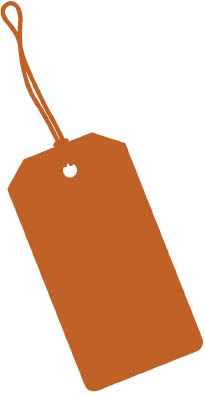
SALES PAGE
The Sales page is an additional page on your blog to sell products or services. This isn’t a necessity, but many bloggers will be trying to earn money from selling their products or services, and this page will give them an opportunity to do that in an area away from the main content of the blog.
Maybe you’re blogging about marketing and advertising and you’re hoping to sell your services as a consultant. Maybe you’re a fashion designer and you’d like to sell your designs. Maybe you’re a writer and you want to increase your book sales.
The Sales page gives you a place to present your value proposition, establish prices, and provide people with a way to either pay and purchase something right from your blog, click on a link to another website like Amazon.com where they can make a purchase, or get in touch with you because they’re interested in what you’re selling.
Many bloggers start out without anything to sell, but once they establish themselves in the field, they find that the best way to make money is by selling products or services from their blog. This page may be something that you add at a later time.
Design Matters
 Why is blog design so important?
Why is blog design so important?
Good visuals and curated design give authority and credibility and affect perceived usability.
A bit of originality allows you to be recognized.
A good design with structured and quality content contribute to keep the users on your website the longest.
 What mistakes have you seen in blog design?
What mistakes have you seen in blog design?
The most frequent mistakes I see are that designers try to replicate the design and the style of other successful blogs.
There are inherent problems related to this approach.
• Sometimes the original design is not so good.
• Often yours is a different problem that requires a different solution in order to work.
It’s much better to try to understand why this solution is used and why it works in that context.
Other frequent blog design mistakes:
• Cluttered interfaces with the attempt to include as much content as possible in a webpage.
• Advertisements placed in misleading ways.
• Designs without a precise personality, in an attempt to please too many people.
 What are some of your favorite blog designs?
What are some of your favorite blog designs?
A very good one; it combines a minimal design with personality. To say nothing about the content, it’s very thoughtful and never banal.
A must-read for type lovers with a great use of negative space and, obviously, with great typography.
A very minimal but equally effective approach.
A pleasure to browse through.
A totally different approach from those listed above. I’m totally in love with this design; it’s creative, curated, and so tailored to the audience.
—Michela Chiucini
Web Is Love webislove.com

You’ve named your blog. You’ve purchased a URL to host your blog that supports that name.
You’ve created a logo that showcases a little bit of your style and color scheme.
You’ve established a look and feel for your blog that utilizes color to welcome readers and help them feel at home on your blog.
You’re using a font that makes reading easy.
And you’ve added some supporting pages to round out your blog and create a fuller user experience.
This is your blog. It’s the largest piece of you that readers will come to know. It’s the very foundation of your brand, which you’ll use to grow and find success. In the material that follows, we’ll take what you’ve built and start to look outward. We’ll discuss ways that you can grow your brand by reaching out to others, establishing yourself on social media platforms, and earning credibility. And then we’ll take it one step further and work through the various ways that you can attract an audience and monetize or earn money with your blog.
WE HOPE YOU’RE ENJOYING THE HOOK SO FAR.
Many of the early successful bloggers started out with little or no formal training. That’s because they invented the field, and no training was made available to them. They carne before us and paved the way. And through them, we’ve learned what it takes to make it as a blogger.
At the New York Institute of Career Development, we put those techniques into our Complete Course in Professional Blogging. Not only that, but we rounded up hundreds of successful bloggers who were eager to share their input and advice with people who were learning the field.
Our students are new bloggers, experienced bloggers who want to improve the quality of their content and drive more traffic, and bloggers who have been at it for awhile and want to use their blog to earn real money. Many dream of the day when they can blog full time, earning as much money as they would with a full-time job.
IT’S A LONG JOURNEY, BUT WE’RE HERE TO HELP MAKE SURE YOU GET THERE.
We invite you to take a look at our course risk-free and decide if it’s right for you. Our no-risk refund policy promises that you have 21 days after you receive your first set of materials to review them and decide whether our course is right for you. If not, you can return it and we’ll refund every penny. If we were not extremely confident in the quality of our course, we could not afford to offer such a strong refund policy.
REQUEST A FREE COURSE CATALOG AND RECEIVE A TUITION DISCOUNT CERTIFICATE
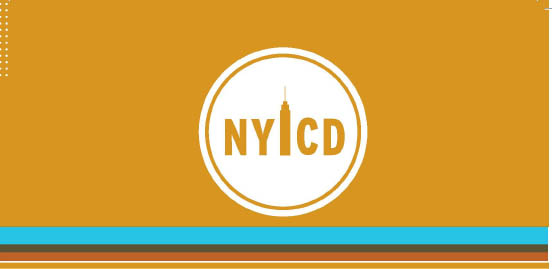
“WITH OVER 50,000 NEW BLOGS STARTING
EACH DAY, BLOGGERS WHO TAKE THIS
COURSE WILL HAVE MAJOR ADVANTAGES
OVER EVERYONE ELSE IN THIS CROWDED
FIELD. THEY’LL BE MORE PREPARED TO
STAY WITH THEIR BLOG, GROW THEIR
AUDIENCE, SHARPEN THEIR BRAND, THINK
MORE STRATEGICALLY, IMPROVE THEIR
WRITING AND CORE BLOGGING SKILLS,
AND MAKE MORE MONEY ONLINE.”
- JAY JOHNSON, CREATOR OF THE PROFESSIONAL BLOGGING COURSE
AND SUCCESSFUL BLOGGER AT DESIGN2SHARE.COM
REQUEST A FREE COURSE CATALOG AND RECEIVE A TUITION DISCOUNT CERTIFICATE
1.800.445.7279
